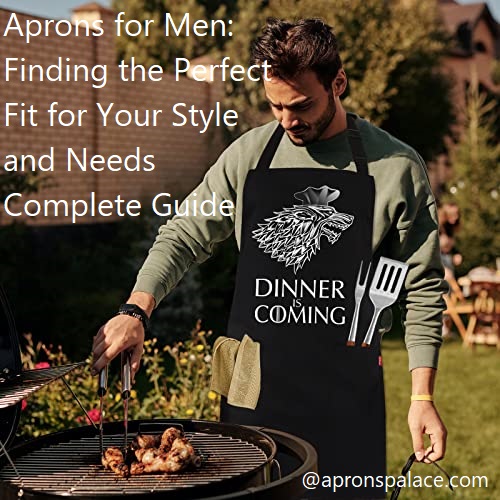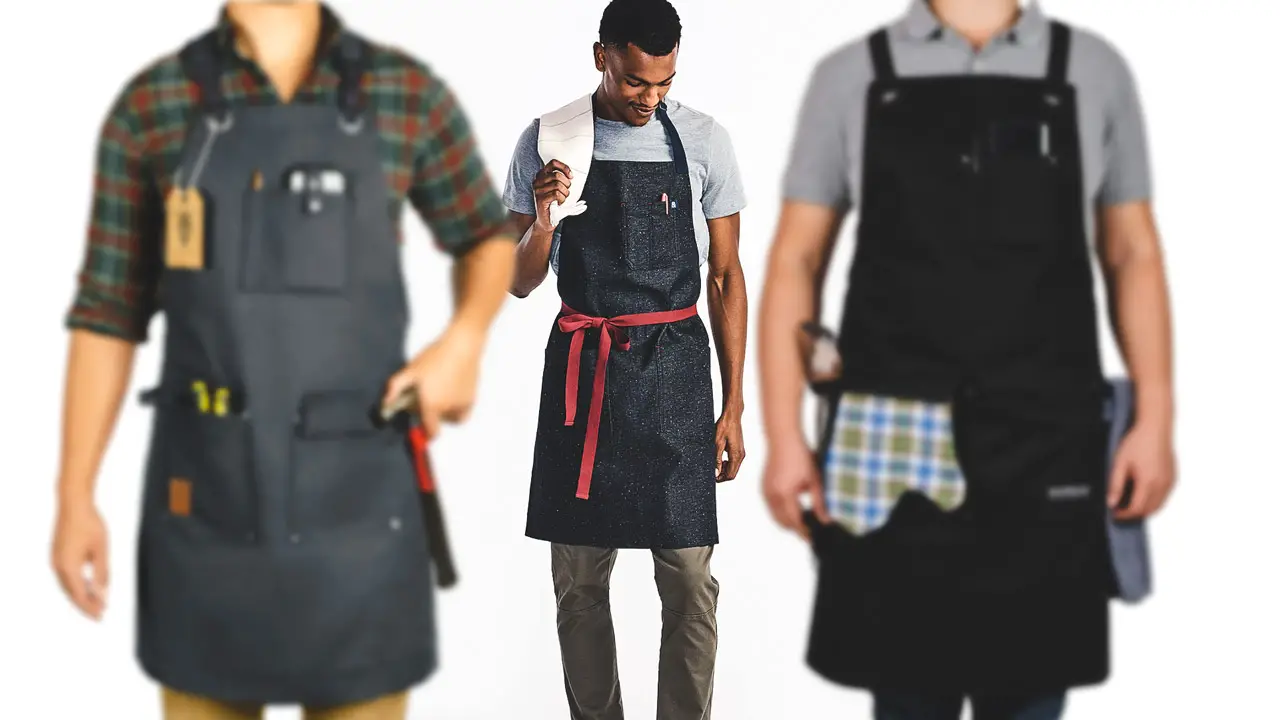Are you looking for the perfect apron for your style and needs? You’ve come to the right place!
In this guide, we’ll provide an overview of men’s aprons, offering advice on how to find one that fits your look and lifestyle. So don’t wait any longer – it’s time to find the perfect apron for you!
The apron is a timeless piece of apparel that has been around for centuries. From chefs to blacksmiths, carpenters to mechanics, the apron is used for protection and practicality in many different working environments. In recent years, aprons have seen a resurgence of popularity and more men are opting for classic styles when cooking and grilling at home or in commercial kitchens. This complete guide will help you find the perfect apron for your style, comfort level and needs.
We’ll discuss why it’s important to wear an apron while cooking; which materials are best suited to different kinds of work; how to measure your body size for an accurate fit; types of cuts, pockets and closures; choosing colors and patterns to match your style; as well as best practice care tips for keeping your apron looking new.
Let’s start by discussing why it’s important to wear an apron when cooking.
Definition of Aprons and their use
Aprons are essentially worn over clothes to protect them from dirt, dust, and food and beverage splatter. Often seen as a traditional garment in the kitchen or crafts studio, aprons protect your clothing while you work. They also can add style to any environment while keeping you and your clothes looking neat.
There are many different types of aprons, so consider which best suits the activity at hand. Unisex bib aprons, for instance, are often used when serving food or drink as they offer protection from messes while still allowing a wide range of movement. Waist aprons do not provide as much protection but can offer a more fashionable look depending on their style as well as less restriction of movement if worn with shorter garments.
The style and materials used for men’s aprons matter too: heavier canvas is best for outdoors activities like grilling or gardening; lighter denim is preferable when working inside where the fabric won’t absorb heat; cotton twill works best in professional spaces such vacuum-sealed chefs coats are ideal when working in high-end restaurants; and antimicrobial Poly-Cotton blend materials provide extra protection when dealing with bacteria in environments like hospitals. Different fabrics provide different levels of comfort and protection, therefore it is important to consider which material best suits your needs before purchasing an apron specifically designed for men.

Importance of finding the perfect fit for men
Finding the perfect size, style and fit for an apron for men is essential for comfort and practicality when working. The right apron can provide additional protection from the elements, stains and dust, depending on the job.
It’s important to note that not all aprons are made alike – some may be too short or too long, others may be too tight or too loose and it’s important to try on different sizes and styles. Also, if you plan on wearing other accessories (gloves, hat, etc.) it’s important to consider this as well when selecting an appropriate apron size.
If a pre-made apron doesn’t fit properly using sizing guides provided by manufacturers is recommended. By taking the time to find an appropriately fitting apron you’ll be sure that you have maximum coverage while still maintaining comfort while working or entertaining.
Factors to Consider When Choosing an Apron for Men
When selecting the perfect apron for men, there are a few essential factors to take into consideration. First and foremost, one should consider the type of protection and coverage desired from the apron, as different aprons offer different levels of protection from spills and messes.
Additionally, it is important to factor in the material of which the apron is made — cotton is often desired for day-to-day usage as it offers breathability, while canvas or leather provide more coverage with an extra layer of durability. Additionally, styles may differ in length as well as detailing such as pocketing — pockets are handy for quick item storage while on the job.
Furthermore, certain aprons may also feature adjustable straps or ties so that they can be fitted to personal needs accordingly. Lastly, considering individual aesthetic preferences such as color or pattern will also narrow down choices so that one finds an apron that suits their style best.
Material
When purchasing an apron for men, material is a very important factor to consider. The selection of materials used in aprons today is quite wide and includes natural and synthetic fabrics. Each options offers different levels of durability, comfort and protection. Here are some of the most popular choices:
Cotton– Cotton is breathable and lightweight, making it an ideal choice for everyday use in the kitchen or workplace. It also has inherent water and stain-resistant qualities, making it a great choice for men who need protection from spills. Cotton aprons are relatively easy to care for but may not offer as much coverage or protection for heavier tasks requiring more durability.
Denim– Denim fabric is thicker and very durable, making it ideal for heavier duty jobs requiring more coverage and protection from spills or messes. It also looks great when dressed up with an apron pocket or contrasting trim colors. However, denim fabric can be hot during warmer weather so it may not be the best choice if you plan on wearing your apron all day long.
Synthetic– Synthetic fabrics such as polyester are often used in men’s aprons due to their durability, water-resistance and wrinkle-free properties. They can stand up to heavy wear without losing their shape over time and come in many colors that won’t fade easily with washing or wear. However they lack the natural softness of other materials such as cotton so if comfort is your primary concern you might want to choose another option instead.
Length and Width
When it comes choosing the right apron for men, length and width are two size factors that should not be overlooked. It is essential to find an apron that has the appropriate length for your body type and provides enough coverage for your needs. Looking for an apron that is overly long or short can lead to difficulties in performing tasks. Similarly, selecting an apron with inadequate width will not provide adequate coverage from spillage and mess.
When selecting the ideal length of an apron, consider how you want it to look when you’re wearing it. Generally speaking, longer aprons will provide more coverage, but if you’re planning on using the same apron both indoors and outdoors, choosing one of more moderate length might be best. The average apron measures between 32-36 inches in length from top to bottom with 14-15 inches between front the neckline of the bib and bottom hem of skirt or kilt portion.
Width also matters when it comes to wearing an apron designed for men. As mentioned earlier, having enough fabric along your waistline is important in order to protect against spills, splatters and messes from various tasks performed throughout the day. The standard width for most aprons ranges from 28-34 inches wide with 16-20 inches long across back straps or suspenders if applicable. If extra fullness is desired for greater protection around torso area then consider investing in an extra-wide option ranging anywhere 36 -48 inches measured at widest settin point around waistline.
Straps and Ties
When choosing the right apron for your needs, it’s important to consider how the straps and ties are designed. Depending on their function, they may be made of different materials. All straps and ties should be of sufficient thickness to provide adequate support. It is important to test the fit before making a purchase.
Straps: Straps should evenly distribute weight so as not to dig into your shoulders or leave strain marks. For this reason, look for adjustable straps with metal buckles or sliding clips for easy adjustment and comfortable fit.
Silk/Nylon Ties: Ties tend to come in two basic types – silk or nylon. Silk ties are more durable than nylon due to their looped construction which can create a tighter hold when needed, however they take longer to tie and untie so bear that in mind when you’re looking for an apron that can quickly be pulled off at peak times. Nylon ties are easier to tie and untie but tend not to be as strong or secure when tied tightly – very much dependent on how well the knot is done.
Elastic Waistbands: An elastic waistband offers a comfortable fit by allowing you some room to breathe while also providing exceptional support if used in combination with tie backs or snaps closures along the sides of the waistband. Be sure to try it on first as elasticity varies among manufacturers and styles; not all elastic waistbands are created equal!
Buttonholes: Many aprons offer buttonholes along the chest area – these enable buttons services such as tying bibs closed at appropriate restaurant temperature levels whilst running around serving customers hot food orders without compromising safety standards!

Pockets
When you’re shopping for an apron, one of the key features to take into account is the number and size of pockets included. The type, size, and placement of pockets varies depending on the apron’s purpose, whether it be for cooking or gardening.
For cooking aprons, larger and more plentiful pockets are beneficial as they provide you with the room to store recipes or kitchen tools such as utensils, measuring cups and spoons while you prep meals. For example, some aprons include side zip pockets that are designed to fit chef knives or a kitchen thermometer. Other aprons may feature three-part divided waist pockets that can fit items like markers or spoons. These types of handy designs help make sure your supplies are easily within reach when needed.
Gardening aprons may have fewer but larger front pockets specifically designed to carry gloves and hand clippers while working in the yard. This can be particularly helpful for men looking for quick access to items kept in these depths since larger items such as phones tend to fit comfortably in these deeper pouches without worry about their safety from dirt and moisture.
Matching Aprons to Your Needs
Choosing the proper apron for your needs is an important factor in ensuring that you get the most out of the working experience. It’s important to note that not all aprons are made the same, with different qualities and sizes available to suit your individual needs. Matching an apron with the type of work you are doing can help keep you organized and comfortable while protecting your clothing while on the job.
The types of working environments can range from home kitchen use to industrial settings. For home use, purchasing a cotton bib-style apron comes with several advantages including style variation and extra protection against spills in comparison to more lightweight waist aprons commonly seen used by waitstaff. On the other hand, heavier cloth styles are best suited for more intensive industrial activities, such as welding or butchering, as these heavier materials can provide extra protection from sparks or sharp edges that may be encountered in these fields.
Matching an apron size to your body type is also important for getting the most out of an apron purchase. Apron sizes typically run from size Small to XXL and beyond; these sizes may vary depending on which supplier you choose but usually accommodate chest/waist measurements up to 60-64 inches for men’s styles. Again understanding what type of work will be performed will inform how much coverage is necessary—light meal prep might require less coverage then carpentry projects where larger pockets might be desirable for tools and supplies—and what kind of materials are ideal in order to make those tasks efficient and safe.
Speak with professionals in related industries that involve similar tasks if possible; they generally have good insight regarding which designs work best within certain contexts based on their personal experiences doing their specific jobs wearing different types of aprons over time. Doing research beforehand can help save time when it’s necessary to purchase new aprons or replace old ones down the road that no longer fit correctly or protect adequately enough against hazards associated with certain tasks being performed during daily use.
Cooking aprons
Cooking aprons are some of the most popular apparel items for men, due to their stylish look and functionality. They come in a variety of styles and materials, allowing you to choose one that best fits your style and needs. The right apron can be a great way to add a bit of personality to your cooking experience. Before making your purchase, consider the following factors:
Fabric – Look for an apron made from sturdy fabric that will last through plenty of wear and tear. Aprons made from cotton, linen or denim are all excellent options as they offer durability as well as comfort.
Style – Choose an apron that is representative of your own personal style. While there are classic designs available, more modern styles are gaining popularity as well. Consider how you want the overall look of the apron to fit into your kitchen aesthetic and choose accordingly.
Design Elements – Many aprons have extra features such as pockets, adjustable straps or tool loops for easy access to utensils while cooking or baking. You can also find models with special designs like customizable embroidery or unique patterned fabric selections.
Additional Details – Look at the quality details such as reinforced waistbands or sewn-in creases to ensure it will provide long-lasting wear and tear protection during multiple uses in the kitchen. If you plan on washing in between uses, also pay attention to any instructions regarding laundering instructions which should be followed carefully so they don’t shrink or fade over time.
Gardening aprons
Gardening aprons are a great way to protect your clothes while you work in the yard or garden. They are typically made of lightly textured fabric, such as canvas or heavy cotton, and usually have adjustable straps for a comfortable fit. Some even come with pockets that can be used to store small tools, seeds, and other supplies. The most important thing is to ensure the apron is not too bulky and can be worn comfortably while you’re gardening.
When shopping for a gardening apron, it’s important to consider the size and fit. Most aprons will be adjustable so you can get the perfect fit for your personal measurements. There are also various styles available, so make sure you find one that matches your tastes or preferences in terms of color, pattern or design. Many aprons also come with extra features such as pockets for storage and/or longer ties or straps for added security around the waist or neck area. Additionally, when selecting an apron it is important to choose one made from durable material that can withstand long-term exposure to dirt and outdoor elements without showing signs of wear and tear too quickly.
Woodworking aprons
When it comes to woodworking, apron is an essential item of clothing. It will protect your clothes from splinters and sawdust while you work in your workshop. Many different types of aprons exist, but if you’re looking to find the perfect fit for your style and needs, consider investing in a woodworking apron.
Woodworking aprons come with many features which make them ideal for working with any kind of wood. They have multiple pockets to store smaller tools like knives and chisels, as well as constructed adjustable straps so they can fit a wide range of sizes. Most are made with heavy duty canvas that can withstand wear and tear, making them longer lasting products that you won’t need to replace soon after purchase. Furthermore, woodworking aprons are designed to keep you comfortable while you work by cushioning your arms from jagged edges on the wood or tools trying to control the stock material.
No matter the type of project or material that you’re working with, there is an ideal style of an apron available for your needs. It’s important that you take the time to find what fits best for you in order to get the most out of it during those long days in the workshop!
Restaurant aprons
In a professional kitchen or restaurant setting, an apron is a tried and true essential. Here, staff can benefit from the added protection of an apron made with the proper material to keep the food environment hygienic and promote easy cleaning. When it comes to restaurant aprons, there are many features to consider in order to select the right option for your unique needs.
First and foremost, professional standards require all front-of-house staff to wear a full-length apron. The fabric should be durable enough to withstand daily use over weeks and months on end as well as protect against food spills, stains, and other contaminants. Breathable fabrics such as twill or cotton are ideal for kitchen staff dealing with hot surfaces throughout the day. When choosing colors for restaurant aprons, white is typically preferred for its versatility when it comes to staining; however darker colors can also offer more coverage. Additionally, extra long straps provide maximum comfort during extended shifts in high activity levels; tie-back or adjustable options can also help ensure that staffers are untied from their aprons in an emergency situation.
Different materials are suited to unique needs as well; choose heavier denim if you’re looking for added protection while working with knives and heavier tools; anti-tarnish fabric may be best if you anticipate coming into contact with harsh chemicals or wet substances often multiple times a day – both of these features will help prolong the life of your garment while still offering optimal comfortability. Some aprons also feature waterproof pockets and reinforced durability zones at stress points such as neck loops or low panels that would otherwise wear down faster than other locations on the garment due to constant movement throughout shifts. Not only do these additional features offer better protection but they can avoid unnecessary downtime replacing more damaged clothing items more often than necessary
No matter what type of settings you’re working in, selecting an ergonomically designed option ensures optimum performance from start to finish every day of your shift. With this guide on your side, you now understand some key elements when considering which restaurant aprons will be most beneficial for your specific style and needs.

Conclusion
When it comes to finding a perfect-fitting apron for men, there are some very important factors to consider. Think about your body shape, material choice, and the style of apron you’d prefer. It’s also important to think about the length you need and if you want any pockets or loops.
Whether you’re looking for an all-purpose apron, a stylish addition to your evening wear, or something more robust for outdoor work, this guide can help you find the perfect fit. It’s the best way to guarantee that your apron meets all of your needs now and in the years to come.
FAQ’s
How do I choose a good apron?
When choosing a good apron, consider the purpose of the apron, the material it’s made from, the size and fit, and any additional features that may be important to you.
Do men look good in aprons?
Yes, men can look great in aprons! It all depends on the style of the apron and how it’s worn.
How long should a man’s apron be?
The length of a man’s apron will depend on personal preference and the type of work being done. Some prefer a shorter length for ease of movement, while others prefer a longer length for more coverage.
What are the different types of aprons?
There are many types of aprons, including bib aprons, waist aprons, cobbler aprons, bistro aprons, and more.
How do I choose an apron size?
To choose the right apron size, measure your waist or chest and consult the sizing chart provided by the manufacturer.
What material is best for aprons?
The best material for an apron depends on the intended use. For example, cotton is a popular choice for kitchen aprons, while leather or canvas may be better for heavy-duty work.
What color is best for apron?
The best color for an apron will depend on personal preference and the intended use. Some prefer darker colors that won’t show stains, while others prefer brighter colors for a more fun or fashionable look.
What are two types of aprons?
Two types of aprons are bib aprons, which cover the chest and tie at the back, and waist aprons, which tie at the waist and cover the lower body.
What is the best apron to protect clothing?
The best apron to protect clothing will depend on the type of work being done. For messy cooking or gardening, a full-coverage bib apron may be best, while for lighter work, a waist apron may suffice.
What is the purpose of an apron?
The purpose of an apron is to protect clothing from stains and damage during messy or dirty work. Aprons can also serve as a fashion accessory or part of a uniform.
See more-
- Best cooking aprons for guys 2023
- Best hair stylist aprons 2023
- Best leather aprons 2023
- Best radiation aprons 2023
- Best waitress aprons 2023

Douglas Keefer is the CEO and author of apronspalace.com and Informative Website. With his extensive knowledge and expertise in the world of aprons, he has helped thousands of people find the perfect apron for their needs. Douglas’s commitment to transparency and honesty has made apronspalace.com stand out in a sea of biased reviews and sponsored content. He is a true pioneer in the world of aprons and a passionate advocate for the culinary arts


